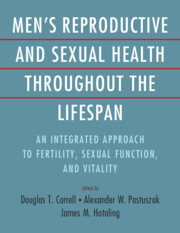 Men's Reproductive and Sexual Health Throughout the Lifespan
Men's Reproductive and Sexual Health Throughout the Lifespan from Section 2 - The Biology of Male Reproduction and Infertility
Published online by Cambridge University Press: 06 December 2023
We have previously reported in several publications the existence of a nuclease that is present in the luminal fluid of the epididymis and in higher concentrations in the lumina fluid of the vas deferens in the mouse. This luminal nuclease has the ability to digest the sperm DNA into loop-sized fragments but is restricted to digesting DNA that is not bound by protamines. In this chapter, we describe new data that show that the luminal nuclease is active in SDS for up to 30 min, complicating the analysis of sperm DNA damage that must be extracted by SDS for electrophoretic analysis on gels. High concentrations of EDTA can protect the DNA from the luminal nuclease if added before SDS is applied. This new data provides an update on our toroid loop model for sperm chromatin structure. We discuss the implications of this updated model for the study of sperm chromatin structure and for clinical assays for sperm DNA damage.
To save this book to your Kindle, first ensure [email protected] is added to your Approved Personal Document E-mail List under your Personal Document Settings on the Manage Your Content and Devices page of your Amazon account. Then enter the ‘name’ part of your Kindle email address below. Find out more about saving to your Kindle.
Note you can select to save to either the @free.kindle.com or @kindle.com variations. ‘@free.kindle.com’ emails are free but can only be saved to your device when it is connected to wi-fi. ‘@kindle.com’ emails can be delivered even when you are not connected to wi-fi, but note that service fees apply.
Find out more about the Kindle Personal Document Service.
To save content items to your account, please confirm that you agree to abide by our usage policies. If this is the first time you use this feature, you will be asked to authorise Cambridge Core to connect with your account. Find out more about saving content to Dropbox.
To save content items to your account, please confirm that you agree to abide by our usage policies. If this is the first time you use this feature, you will be asked to authorise Cambridge Core to connect with your account. Find out more about saving content to Google Drive.